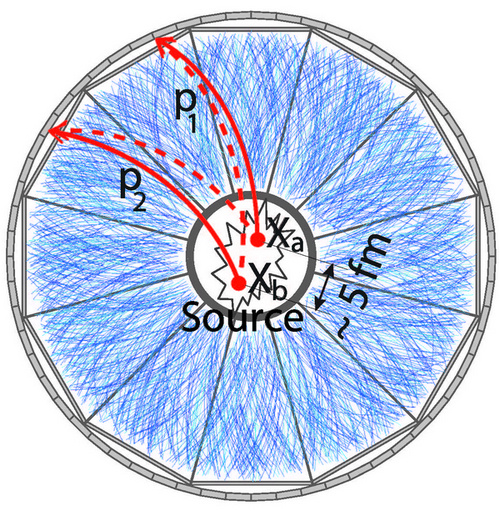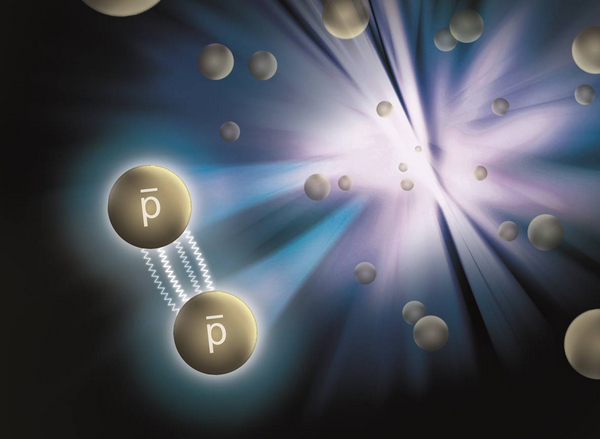
The STAR collaboration composed of 52 institutions from 12 countries at the Relativistic Heavy Ion Collider (RHIC)— a particle accelerator used to simulate and study conditions of the early Universe at the U.S. The Department of Energy’s Brookhaven National Laboratory (BNL) has for the first time measured the forces that make certain antimatter particles stick together. The findings, online published in Nature on November 5, 2015, may yield clues to what led to the scarcity of antimatter in the cosmos today. The first measurement of interaction between antimatter, leaping from qualitative study to quantitative interaction measurement, means a big step of human to study the antimatter.
Antimatter is extremely rare in normal condition. The forces between antimatter particles - in this case antiprotons - had not been measured before. At the Relativistic Heavy Ion Collider, head-on collisions of gold ions moving at nearly the speed of light simulate conditions just after the Big Bang. RHIC produces a plasma of the smallest components of matter — the quarks and gluons that make up ordinary protons and neutrons. Quark-Gluon Plasma (QGP) is the hottest matter ever created in a laboratory, which is about 4 trillion degrees Celsius, or 250,000 times hotter than the center of the Sun. With abundantly produced anti-nucleons after cooling down of QGP, RHIC has the excellent capability of conducting the study of interaction between antiprotons. The knowledge of interaction between two antiprotons, the simplest system of anti-nucleons (nuclei), is a fundamental ingredient for understanding the structure of more sophisticated anti-nuclei and their properties.
With abundant amount of antiprotons, the scientists measured the correlation function of antiproton-antiproton pairs. After considering the residual correlation due to the secondary antiprotons that decayed from other particles, they obtained the pure antiproton-antiproton correlation function. By applying the quantum theory of multi-particle correlation, two key parameters that characterize the corresponding strong interaction: namely, the scattering length (f0) and effective range (d0) were extracted. Scientists found that within errors, the f0 and d0 for the antiproton-antiproton interaction are consistent with their antiparticle counterparts – the ones for the proton-proton interaction. Like the force that holds ordinary protons together within the nuclei of atoms, the force between antiprotons is attractive and strong. The current measurement is a test of matter-antimatter symmetry, more formally known as CPT — a fundamental symmetry of physical laws under the simultaneous transformations of charge conjugation (C), parity transformation (P) and time reversal (T).
This research offers a new way to understand the matter-antimatter symmetry. At the beginning of the Universe, the Big Bang produced matter and antimatter in equal amounts. But that's not the world we see today: instead antimatter is extremely rare. It remains a huge mystery to scientists. In fact, the present measurements show no difference between matter and antimatter in the way the strong force behaves. That is, within the accuracy of these measurements, matter and antimatter appear to comply with CPT symmetry in the level of interaction. That points scientists towards more study of antimatter production, interaction and evolution mechanism explanations to explain the matter-antimatter asymmetry. So the antimatter study has bright prospects.
The STAR-China group led by Professor MA Yugang is one of main components of the whole STAR collaboration. The group includes Shanghai Institute of Applied Physics-CAS, University of Science and Technology of China, Tsinghua University, Central China Normal University, Institute of Modern Physics-CAS, and Shandong University etc. In the present research, Professor MA Yugang from Shanghai Institute of Applied Physics and his team presented the ideal of the current research work in 2012 and then spend over three years to finish this original and hard study, cooperating with TANG Aihong et al. from the Brookhaven National Laboratory. And ZHANG Zhengqiao, a PhD student in MA Yugang's team, accomplished all the data analysis.
In history of the systematic research on antimatter, Professor MA Yugang and his team have made significant contributions on the discoveries of the first antimatter hypernucleus (namely antihypertriton) in 2010 and the heaviest antimatter nucleus observed so far (namely antihelium-4) in 2011. The corresponding papers have been respectively published in Science (2010) and Nature (2011) magazine. The former research work has been selected as one of the Top Ten Sciences Progress in China in 2010 and the latter one was selected as one key item of 2012 Science Progress Reports of the CAS due to significant contribution on international collaboration from the Chinese scientists.
The current research was partially supported by the Major State Basic Research Development Program project (“Study on the nuclear matter at extreme high temperature and density”), NSFC Innovation Team (“Heavy-ion Physics”) and key international cooperation fund.

Figure 1: A schematic of the two-particle correlation process in a heavy-ion collision. (Image by Brookhaven National Laboratory)

Figure 2: A carton picture of antiproton-antiproton interaction. (Image by Brookhaven National Laboratory)

86-10-68597521 (day)
86-10-68597289 (night)

52 Sanlihe Rd., Xicheng District,
Beijing, China (100864)

